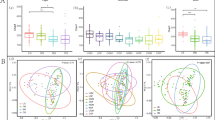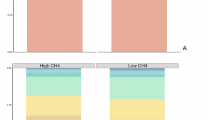Abstract
This study evaluated the effects of an increasing proportion of dietary grain on changes in bacterial populations in the goat ileum. Nine ruminally fistulated, castrated male goats were assigned to three diets in a completely randomized design. Goats were fed three different dietary treatments containing different proportions of corn grain (0, 25, and 50 %). The pH of the ileal contents and rumen fluid (P = 0.015) linearly decreased (P < 0.001), and the acetate, propionate, butyrate, and total volatile fatty acid in ileal contents increased (P < 0.05) with increases in dietary corn, and similar results were also observed in rumen fluid. The barcoded DNA pyrosequencing method was used to reveal 8 phyla, 70 genera, and 1,693 16S operational taxonomic units (OTUs). At the genus level, the proportions of Acetitomaculum, Enterococcus, Atopobium, unclassified Coriobacteriaceae, and unclassified Planctomycetaceae were linearly decreased (P < 0.05) with increases in corn grain. At the species level, high grain feeding linearly decreased the percentage of OTU8686 (unclassified Bacteria) (P = 0.004). To the best of our knowledge, this is the first study using barcoded DNA pyrosequencing method to survey the ileal microbiome of goats and the results suggest that increasing levels of dietary corn change the composition of the ileal bacterial community. These findings provide previously unknown information about the ileal microbiota of goats and a new understanding of the ileal microbial ecology, which may be useful in modulating the gut microbiome.




Similar content being viewed by others
References
Alston TA, Mela L, Bright HJ (1977) 3-Nitropropionate, the toxic substance of Indigofera, is a suicide inactivator of succinate dehydrogenase. Proc Natl Acad Sci USA 74:3767–3771
Anderson R, Rasmussen M, Jensen N, Milton J, Allison R (2000) Denitrobacterium detoxificans gen. nov., sp. nov., a ruminal bacterium that respires on nitrocompounds. Int J Syst Evol Microbiol 50:633–638
Aslan V, Thamsborg SM, Jørgensen RJ, Basse A (1995) Induced acute ruminal acidosis in goats treated with yeast (Saccharomyces cerevisiae) and bicarbonate. Acta Vet Scand 36:65–77
Callaway TR, Dowd SE, Wolcott RD, Sun Y, McReynolds JL, Edrington TS, Byrd JA, Anderson RC, Krueger N, Nisbet DJ (2009) Evaluation of the bacterial diversity in cecal contents of laying hens fed various molting diets by using bacterial tag-encoded FLX amplicon pyrosequencing. Poult Sci 88:298–302
Cunha IS, Barreto CC, Costa OY, Bomfim MA, Castro AP, Kruger RH, Quirino BF (2011) Bacteria and Archaea community structure in the rumen microbiome of goats (Capra hircus) from the semiarid region of Brazil. Anaerobe 17:118–124
Fernando SC, Purvis HT 2nd, Najar FZ, Sukharnikov LO, Krehbiel CR, Nagaraja TG, Roe BA, Desilva U (2010) Rumen microbial population dynamics during adaptation to a high-grain diet. Appl Environ Microbiol 76:7482–7490
Franzolin R, St-Pierre B, Northwood K, Wright AD (2012) Analysis of rumen methanogen diversity in water buffaloes (Bubalus bubalis) under three different diets. Microb Ecol 64:131–139
Frey JC, Pell AN, Berthiaume R, Lapierre H, Lee S, Ha JK, Mendell JE, Angert ER (2010) Comparative studies of microbial populations in the rumen, duodenum, ileum and faeces of lactating dairy cows. J Appl Microbiol 108:1982–1993
Glock RD, DeGroot BD (1998) Sudden death of feedlot cattle. J Anim Sci 76(1):315–319
Gontcharova V, Youn E, Wolcott RD, Hollister EB, Gentry TJ, Dowd SE (2010) Black box chimera check (B2C2): a windows-based software for batch depletion of chimeras from bacterial 16S rRNA gene datasets. Open Microbiol J 11:47–52
Greening RC, Leedle JA (1989) Enrichment and isolation of Acetitomaculum ruminis, gen. nov., sp. nov.: acetogenic bacteria from the bovine rumen. Arch Microbiol 151:399–406
Hedde RD, Lindsey O (1986) Virginiamycin: a nutritional tool for swine production. Agri Pract 7:70
Hoover WH (1978) Digestion and absorption in the hindgut of ruminants. J Anim Sci 46:1789–1799
Huang XD, Tan HY, Long R, Liang JB, Wright AD (2012) Comparison of methanogen diversity of yak (Bos grunniens) and cattle (Bos taurus) from the Qinghai-Tibetan plateau, China. BMC Microbiol 19:237. doi:10.1186/1471-2180-12-237
Hungate RE (1966) The rumen and its microbes. Academic Press, New York, NY
Isaacson R, Kim HB (2012) The intestinal microbiome of the pig. Anim Health Res Rev 13:100–109
Khafipour E, Li S, Plaizier JC, Krause DO (2009) Rumen microbiome composition determined using two nutritional models of subacute ruminal acidosis. Appl Environ Microb 75:7115–7124
Krishnamurthi S, Chakrabarti T, Stackebrandt E (2009) Re-examination of the taxonomic position of Bacillus silvestris Rheims et al. 1999 and proposal to transfer it to Solibacillus gen. nov. as Solibacillus silvestris comb. nov. Int J Syst Evol Microbiol 59:1054–1058
Lee HJ, Jung JY, Oh YK, Lee SS, Madsen EL, Jeon CO (2012) Comparative survey of rumen microbial communities and metabolites across one caprine and three bovine groups, using bar-coded pyrosequencing and ¹H nuclear magnetic resonance spectroscopy. Appl Environ Microbiol 78:5983–5993
Ley RE, Hamady M, Lozupone C, Turnbaugh PJ, Ramey RR, Bircher JS, Schlegel ML, Tucker TA, Schrenzel MD, Knight R, Gordon JI (2008) Evolution of mammals and their gut microbes. Science 320:1647–1651
Lozupone C, Knight R (2005) UniFrac: a new phylogenetic method for comparing microbial communities. Appl Environ Microbiol 71:8228–8235
Majak W (1992) Further enhancement of 3-nitropropanol detoxication by ruminal bacteria in cattle. Can J Anim Sci 72:863–870
Mao SY, Zhang G, Zhu WY (2008) Effect of disodium fumarate on ruminal metabolism and rumen bacterial communities in goat as revealed by denaturing gradient gel electrophoresis analysis of 16S ribosomal DNA. Anim Feed Sci Technol 140:293–306
Morohoshi T, Tominaga Y, Someya N, Ikeda T (2012) Complete genome sequence and characterization of the N-acylhomoserine lactone-degrading gene of the potato leaf-associated Solibacillus silvestris. J Biosci Bioeng 113:20–25
Mukhopadhyay J, Braig HR, Rowton ED, Ghosh K (2012) Naturally occurring culturable aerobic gut flora of adult Phlebotomus papatasi, vector of Leishmania major in the Old World. PLoS ONE 7:e35748
Pandya PR, Singh KM, Parnerkar S, Tripathi AK, Mehta HH, Rank DN, Kothari RK, Joshi CG (2010) Bacterial diversity in the rumen of Indian Surti buffalo (Bubalus bubalis), assessed by 16S rDNA analysis. J Appl Genet 51:395–402
Patel JKM, Jhala MK, Soni P, Shabir N, Pandya PR, Singh KM, Rank DN, Joshi CG (2011) Molecular characterization and diversity of rumen bacterial flora in Indian goat by 16S rDNA sequencing. VetScan 6:77–82
Price MN, Dehal PS, Arkin AP (2009) FastTree: computing large minimum evolution trees with profiles instead of a distance matrix. Mol Biol Evol 26:1641–1650
Pruesse E, Quast C, Knittel K, Fuchs BM, Ludwig W, Peplies J, Glöckner FO (2007) SILVA: a comprehensive online resource for quality checked and aligned ribosomal RNA sequence data compatible with ARB. Nucleic Acids Res 35:7188–7196
Russell JB, Rychlik JL (2001) Factors that alter rumen microbial ecology. Science 292:1119–1122
Saunders DR, Sillery J (1982) Effect of lactate and H+ on structure and function of rat intestine. Implications for the pathogenesis of fermentative diarrhea. Dig Dis Sci 27:33–41
Schloss PD, Westcott SL, Ryabin T, Hall JR, Hartmann M, Hollister EB, Lesniewski RA, Oakley BB, Parks DH, Robinson CJ, Sahl JW, Stres B, Thallinger GG, Van Horn DJ, Weber CF (2009) Introducing mothur: open-source, platform-independent, community-supported software for describing and comparing microbial communities. Appl Environ Microbiol 75:7537–7541
Shanks OC, Kelty CA, Archibeque S, Jenkins M, Newton RJ, McLellan SL, Huse SM, Sogin ML (2011) Community structures of fecal bacteria in cattle from different animal feeding operations. Appl Environ Microbiol 77:2992–3001
Sirohi SK, Singh N, Dagar SS, Puniya AK (2012) Molecular tools for deciphering the microbial community structure and diversity in rumen ecosystem. Appl Microbiol Biotechnol 95:1135–1154
Suľák M, Sikorová L, Jankuvová J, Javorský P, Pristaš P (2012) Variability of Actinobacteria, a minor component of rumen microflora. Folia Microbiol (Praha) 57:351–353
Sun YZ, Mao SY, Zhu WY (2010) Rumen chemical and bacterial changes during stepwise adaptation to a high concentrate diet in goats. Animal 4:210–217
Sundset MA, Praesteng KE, Cann IK, Mathiesen SD, Mackie RI (2007) Novel rumen bacterial diversity in two geographically separated sub-species of reindeer. Microb Ecol 54:424–438
Sundset MA, Edwards JE, Cheng YF, Senosiain RS, Fraile MN, Northwood KS, Praesteng KE, Glad T, Mathiesen SD, Wright AD (2009) Rumen microbial diversity in Svalbard reindeer, with particular emphasis on methanogenic archaea. FEMS Microbiol Ecol 70:553–562
Vahjen W, Pieper R, Zentek J (2010) Bar-coded pyrosequencing of 16S rRNA gene amplicons reveals changes in ileal porcine bacterial communities due to high dietary zinc intake. Appl Environ Microbiol 76(19):6689–6691
Vahjen W, Pieper R, Zentek J (2011) Increased dietary zinc oxide changes the bacterial core and enterobacterial composition in the ileum of piglets. J Anim Sci 89:2430–2439
Van Kessel MA, Dutilh BE, Neveling K, Kwint MP, Veltman JA, Flik G, Jetten MS, Klaren PH, Op den Camp HJ (2011) Pyrosequencing of 16S rRNA gene amplicons to study the microbiota in the gastrointestinal tract of carp (Cyprinus carpio L.). AMB Express 1:41–49
Wang Q, Garrity GM, Tiedje JM, Cole JR (2007) Naive Bayesian classifier for rapid assignment of rRNA sequences into the new bacterial taxonomy. Appl Environ Microbiol 73(16):5261–5267
Williams WL, Tedeschi LO, Kononoff PJ, Callaway TR, Dowd SE, Karges K, Gibson ML (2010) Evaluation of in vitro gas production and rumen bacterial populations fermenting corn milling (co)products. J Dairy Sci 93:4735–4743
Wright AD, Williams AJ, Winder B, Christophersen CT, Rodgers SL, Smith KD (2004) Molecular diversity of rumen methanogens from sheep in Western Australia. Appl Environ Microbiol 70:1263–1270
Wright AD, Toovey AF, Pimm CL (2006) Molecular identification of methanogenic archaea from sheep in Queensland, Australia reveal more uncultured novel archaea. Anaerobe 12:134–139
Wright AD, Auckland CH, Lynn DH (2007) Molecular diversity of methanogens in feedlot cattle from Ontario and Prince Edward Island, Canada. Appl Environ Microbiol 73:4206–4210
Yang LY, Chen J, Cheng XL, Xi DM, Yang SL, Deng WD, Mao HM (2010) Phylogenetic analysis of 16S rRNA gene sequences reveals rumen bacterial diversity in Yaks (Bos grunniens). Mol Biol Rep 37:553–562
Yang S, Ma S, Chen J, Mao H, He Y, Xi D, Yang L, He T, Deng W (2010) Bacterial diversity in the rumen of Gayals (Bos frontalis), Swamp buffaloes (Bubalus bubalis) and Holstein cow as revealed by cloned 16S rRNA gene sequences. Mol Biol Rep 37:2063–2073
Acknowledgments
This study was supported by Natural Science Foundation of China (NSFC) (31172228 and 30810103909), Fundamental Research Funds for the Central Universities (KYZ201114) and R&D Speical Fund for Public Welfare in Agriculture of China (200903003).
Author information
Authors and Affiliations
Corresponding author
Electronic Supplementary Material
Below is the link to the electronic supplementary material.
Rights and permissions
About this article
Cite this article
Mao, S., Huo, W. & Zhu, W. Use of Pyrosequencing to Characterize the Microbiota in the Ileum of Goats Fed with Increasing Proportion of Dietary Grain. Curr Microbiol 67, 341–350 (2013). https://doi.org/10.1007/s00284-013-0371-0
Received:
Accepted:
Published:
Issue Date:
DOI: https://doi.org/10.1007/s00284-013-0371-0




